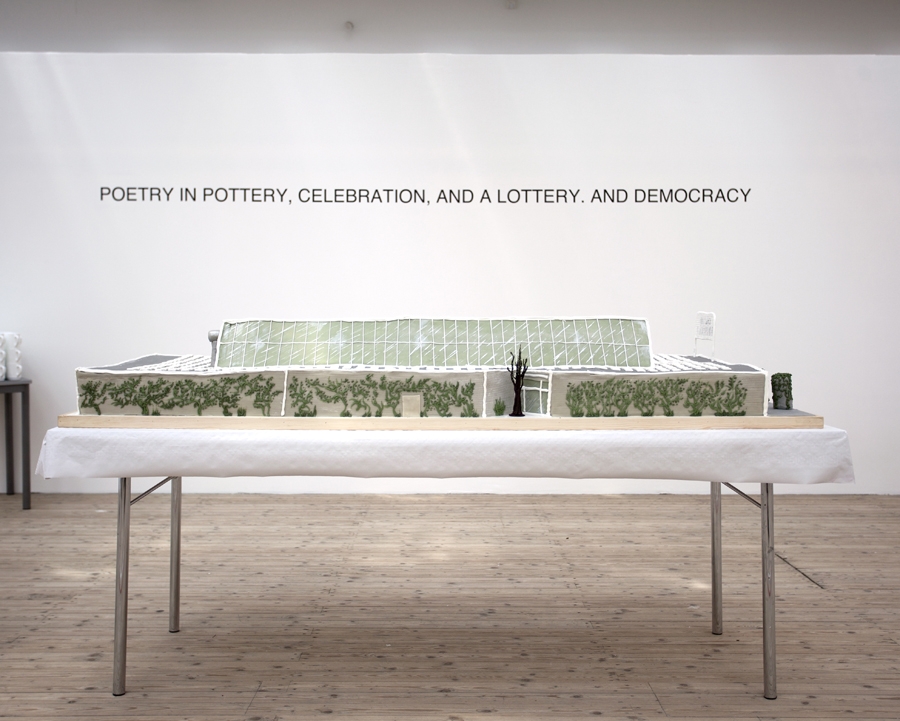Binge-watching Scandisploitation TV series Vikings and reading The Economist’s ‘The Nordic Countries: The Next Supermodel’ issue provided my only research before travelling to the Swedish city of Malmö for its Nordic 2013 festival of art. The vision this created in my head of the Northern European region was one of berserk raiders with an eye for great design, and apocalyptic prophecy but with a good work-life balance and robust welfare system to mitigate the decimation.
Malmö Nordic’s vision, however, is to give an overview of recent art activities as seen through the countries’ collective ‘Nordic perspective’, centering around Malmö’s three main art institutions (Malmö Konsthal, Malmö Konstmuseum and Moderna Museet Malmö) alongside 20-plus small galleries, and project spaces across the city.
I arrive on the Friday opening evening at Malmö Konsthal, the venue for 24 Spaces – a Cacophony, a showcase for non-commerical spaces and institutions, on what feels like the first real day of summer. Having travelled from nearby Copenhagen dressed in deep winter wool and boots, I promptly fall asleep from heat fatigue in a park in front of the building, to be woken by the sound of a woman singing along to synth music from the branches of a nearby tree, as she throws pages of lyrics down on the mass of people now mingling in the sun. I later find out that this is Sarah Lundén’s Frühstück im Grünen, an interpretation of Manet’s saucy Le Dejeuner sur L’Herbe.
Inside the Konsthal there’s a large, scale model of the building, made of cake. An orderly group of visitors are queued up for a slice, mingling and munching away. Next to this giant ‘konstcake’ is a table of white mugs and a water cooler, filled with vodka – all courtesy of Norwegian space Tidens Krav and artist Steinar Hagar Kristensen.
As the title suggests the exhibition includes 24 arts spaces and collectives, among them Norway’s 1857, Denmark’s Pist Protta and Koh-i-noor, Iceland’s Kling & Bang and The Living Art Museum, Sweden’s OIE and Index and Finland’s Ruler and SIC, alongside participation by the respective countries’ art academies, plus projects by a few relatively non-Nordic spaces: Lithuania’s The Gardens and Latvia’s kim? Contemporary Art Centre.
From the delineated floor space to the predilection of galleries to construct furnished faux-office spaces and living rooms, 24 Spaces reminds of Tate Modern’s similarly intentioned exhibition No Soul For Sale from 2010. There’s also a reminder of the criticisms No Soul For Sale received over the decision not to pay fees to participating galleries in Glasgow’s Transmission gallery’s (in collaboration with Edinburgh’s Embassy and Dundee’s Generator Projects) presentation of a meeting table alongside a projected slideshow which clicks through email correspondence from exhibition curator Jacob Fabricius (now across the Øresund’s waters at Copenhagen’s Kunsthal Charlottenborg ), explaining the financial details of the show (€3,000 fees for each space, etc).
Next stop is the opening of Malmö Konstmuseum’s exhibition The Nordic Model®. where Swedish duo Goldin+Senneby are presenting their performance The Discreet Charm. Featuring a sleazy narrator claiming to be a professor in economics from The University of Manchester, it takes the audience on a winding trip through the birth of bio-economics, illustrated by a live projection of a scale model set based on the Konstmuseum. Other artists showing include Ewa Einhorn and Jeuno JE Kim, Joachim Koester, Pia Arke and Superflex.
If The Nordic Model® aims to question preconceptions about the region and its cohesiveness (or lack thereof) then Icelander Ragnar Kjartansson’s Scandinavian Pain at Moderna Museet is an ironic play off of them. Set in one of the Museet’s darkened halls, this iteration of the artist’s well-travelled installation collects together a group of Edvard Munch’s brooding works inside a wooden barn (though the pieces themselves aren’t Munch’s best). If his point could ever be missed, the title of the installation is writ large in a neon sign on the barn’s roof. Kjartansson claims that his work isn’t ironic, but it’s difficult to see it in any other way. Further, it’s hard to see how it’s more complex than my History Channel-informed, berserker-aesthete fantasy of the Nordic. Intent aside, the installation is aesthetically precise in caricaturing oft-repeated Scandinavian cliches such as their existential intensity and relationship to nature.
The previous evening Kjartansson performed Abba’s The Winner Takes It All, video documentation of which is on display in the Museet’s café entrance. I arrive on the Saturday afternoon to catch a group of tired tourists having a cup of coffee, sitting next to Kjartansson’s smiling and slightly embarrassed face, shakily singing the cheesy hit, wringing out its full bathetic potency.
I return to the Malmö Konstmuseum for Swedish artist Olof Olsson’s performance, The Nordic Sound. Outside on the breezy roof terrace under a clear blue sky, Olsson delivers a talk/standup routine, starting with a joke his father used to tell repeatedly before a debilitating stroke took his speech, about a group of reluctantly sober blacksmiths and a ginger biscuit. His talk then takes in the relationship between speaking pitch and business success (demonstrated musically), the Nordic welfare state and architecture and home electronics, among other subjects. As a vision to leave Malmö with it’s a suitably diverse, hilarious and not a little bit melancholic one.
